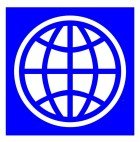Log In
Sign Up

About Us
The World Bank, a member of the World Bank Group, is a vital source of financial and technical assistance to developing countries around the world. Our mission is to fight poverty with passion and professionalism for lasting results and to help people help themselves and their environment by providing resources, sharing knowledge, building capacity and forging partnerships in the public and private sectors.
We are not a bank in the common sense; we are made up of two unique development institutions owned by 188 member countries: the International Bank for Reconstruction and Development (IBRD) and the International Development Association (IDA).
Each institution plays a different but collaborative role in advancing the vision of inclusive and sustainable globalization. The IBRD aims to reduce poverty in middle-income and creditworthy poorer countries, while IDA focuses on the world’s poorest countries.
Their work is complemented by that of the International Finance Corporation (IFC), Multilateral Investment Guarantee Agency (MIGA) and the International Centre for the Settlement of Investment Disputes (ICSID).
Together, we provide low-interest loans, interest-free credits and grants to developing countries for a wide array of purposes that include investments in education, health, public administration, infrastructure, financial and private sector development, agriculture and environmental and natural resource management.
In July 1944 – one year before the end of World War II – delegates from 44 countries met for the United Nations Monetary and Financial Conference held at the Mount Washington Hotel in Bretton Woods, New Hampshire. The conference aimed to create the framework for post-war international economic cooperation and reconstruction. The intellectual leaders at the conference were John Maynard Keynes (Adviser to the Treasury in the United Kingdom), and Harry Dexter White (Assistant Secretary of the Treasury in the United States).
While the conference resulted in the formation of two institutions: the International Monetary Fund (IMF) and the International Bank for Reconstruction and Development (World Bank), the creation of the World Bank was not the primary focus. The majority of time and effort was spent on the IMF Commission under Harry Dexter White’s leadership. The work of the World Bank Commission on the other hand, occurred only in the last few days of the conference and its articles of agreement – primarily drafted by John Maynard Keynes – included rebuilding the economies of countries devastated by war and increasing the economic development of developing countries.
Since 1947, the World Bank has funded over 12,000 development projects, via traditional loans, interest-free credits, and grants.
The World Bank Group works in every major area of development. They provide a wide array of financial products and technical assistance, and they help countries share and apply innovative knowledge and solutions to the challenges they face.
With 189 member countries, staff from more than 170 countries, and offices in over 130 locations, the World Bank Group is a unique global partnership: five institutions working for sustainable solutions that reduce poverty and build shared prosperity in developing countries.
The World Bank Group consists of five organizations:
The International Bank for Reconstruction and Development (IBRD) provides financial development and policy financing
The International Development Association (IDA) provides zero-to low-interest loans and grants
The International Finance Corporation (IFC) mobilizes private sector investment and provides advice
The Multilateral Investment Guarantee Agency (MIGA) provides political risk insurance (guarantees)
The International Centre for Settlement of Investment Disputes (ICSID) settles investment disputes
Related
Company Overview
-
Location: Washington DC
-
Founded: 1944
-
Company Size: 10000+
-
Industry: International Development Agency

